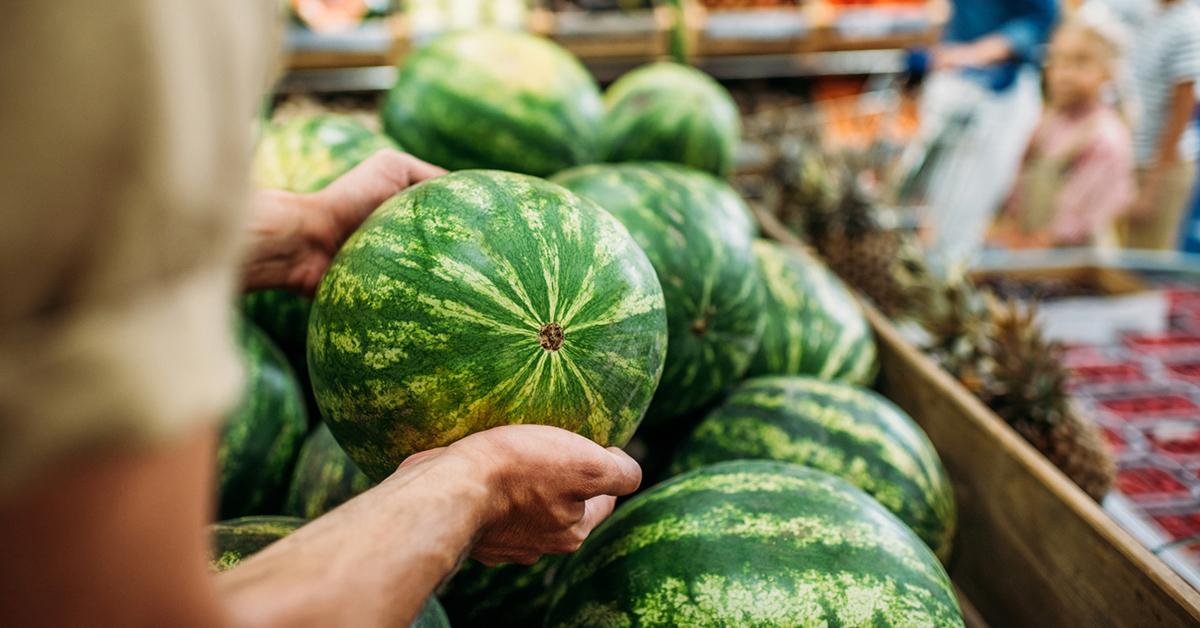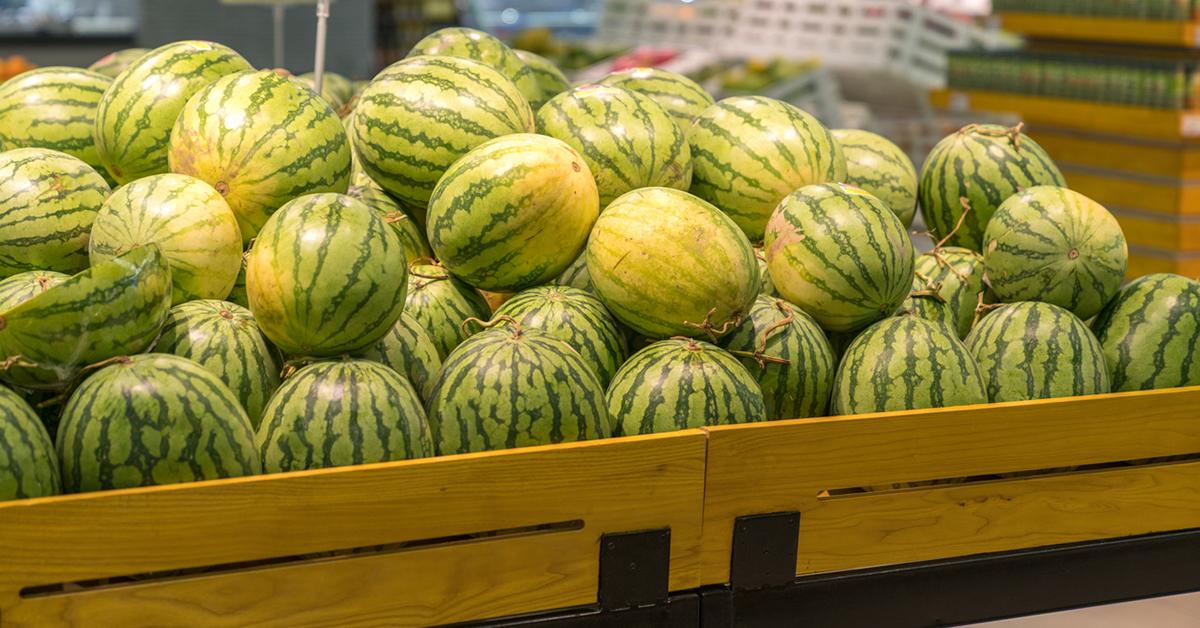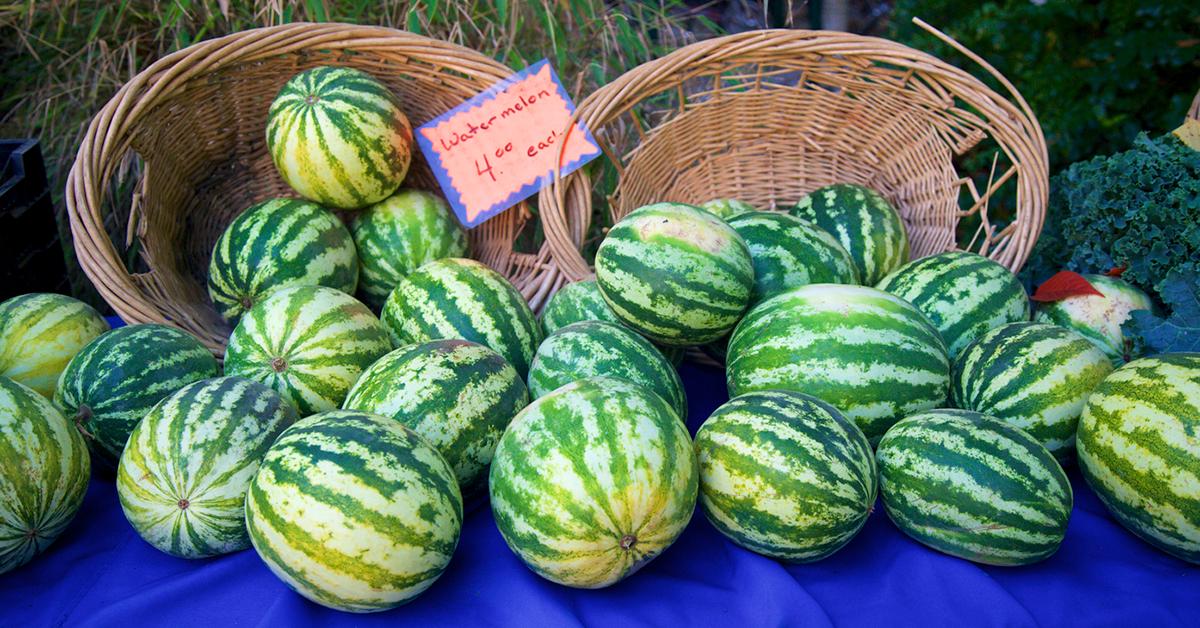How to Pick a Good Watermelon – What to Look For
Summer means watermelon season!
Updated June 18 2020, 7:42 p.m. ET

Watermelon is more than just a superfood. It has amazing health benefits such as improving heart health, lowering inflammation, potentially preventing cancer; not to mention, it’s also one of the best ways (besides drinking eight ounces of water a day) to stay hydrated during the warm summer months.
It even earned the name “nature’s Viagra” after some researchers found it can increase libido? That might be a story for another day — but rest assured that there are endless benefits to adding watermelon to your diet.
In order to reap those nutritious benefits, you first have to know how to pick a good watermelon. What are you supposed to look for in a good watermelon? How heavy should it be and what should a ripe watermelon sound like? Keep reading for all the answers to these watermelon-related questions and tips on how to pick the perfectly ripe watermelon for your next summer BBQ.
How can you tell if the watermelon is ripe?

Get ready to become absolutely ace at determining if a watermelon is ripe. Just as with other fruits, there’s always a secret to ascertaining whether a watermelon is ripe. The key is in three main parts: the watermelon’s weight, color, and sound it makes when you thump it.
Weight
A watermelon should feel very heavy, especially for its size. In fact, weight is a good indicator of ripeness with most fruits and vegetables. A heavier fruit will almost always be the better, riper option than a fruit that feels light to the touch. (Don’t believe us? Try weighing limes and lemons; the heavier ones are always the ripest and juiciest!)
Color
If you’re sorting through the watermelons at the farmers market looking for the greenest of the green skins, we’re sorry to say, but you’re doing it wrong. In actuality, a ripe watermelon will have a yellow spot on one side. This is called the ground spot or belly spot. It may seem counterintuitive but trust us — you want to choose the watermelon with a yellow spot.
Sound
A ripe watermelon should sound hollow when you lightly whack it. We are definitely not suggesting that you drop the watermelon to see what sound it makes; simply thump on the watermelon’s underbelly lightly with your finger. If it sounds hollow inside, it’s most likely ripe.
What is the sound of a ripe watermelon?

The sound of a ripe watermelon should be hollow. Take your finger and lightly thump it against the watermelon skin. Does it sound hollow in there? If so, it’s probably ripe. If the watermelon sounds dull, it may be under ripe or overripe. For that reason, you may want to put that watermelon back and keep looking.
How to pick a good watermelon:
To pick a good watermelon, you want to make sure it is ripe. You can do this by testing out its weight (it should be heavy for its size), color (it should have a yellow spot on one side), and sound (when you lightly thump it, it should sound hollow inside).
Watermelons are generally on the Clean 15 list — meaning they are treated with the least amount of pesticides — but even still, you may also want to consider organic versus inorganic while shopping around for a good watermelon.
What to look for in a good watermelon:

When picking a good watermelon, you want to look for the following indicators of a perfectly ripe fruit. A good watermelon should have a bright green stem if it is still attached; if the stem is dried or brown-looking, move on to the next watermelon because this means you’re looking at an old watermelon, as in, one that was harvested too long ago.
A good watermelon should also have a yellow spot, also known as a ground or belly spot. This is a patch of creamy yellow that indicates the watermelon’s ripeness. If there is no ground spot, the watermelon was probably harvested too early and therefore may be underripe.
The rind of a good watermelon is also very smooth. If there are any bumps, soft spots, or cuts in the watermelon’s skin, it’s a pass.

A faded watermelon skin is also a sign of a good, ripe watermelon. Your intuition may tell you to look for the brightest green watermelon, but in fact, a faded skin is an indicator of healthy sun exposure. That means it’s probably perfectly ripe inside!
Tap the underbelly of the watermelon. Does it sound dull? No-go. If it sounds hollow inside when you tap it, then the watermelon is probably ripe.
The watermelon should also be heavy, especially for its size. If you are unsure of how to measure the weight of a watermelon, hold two at a time to compare them. Do you notice a difference in weight? The heavier watermelon is likely the one that is more ripe.
What is the best month to buy watermelon?
Watermelon is typically in season during the summer. Therefore, the best time to buy watermelon is anytime between May and September.
However, you can find watermelon during other seasons, too, though these options will likely not be as fresh. These watermelons will likely be shipped from Mexico or Central America, making them not as sustainable or as fresh as the locally grown watermelons in summer.